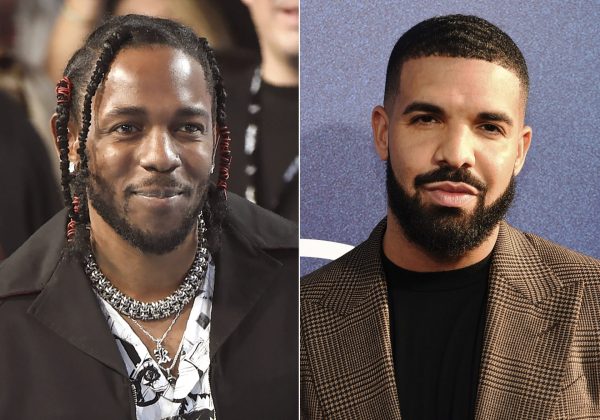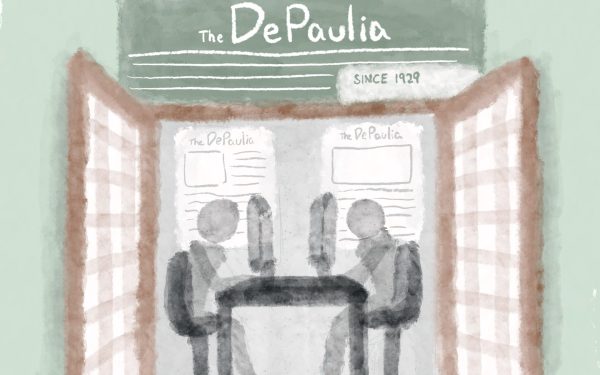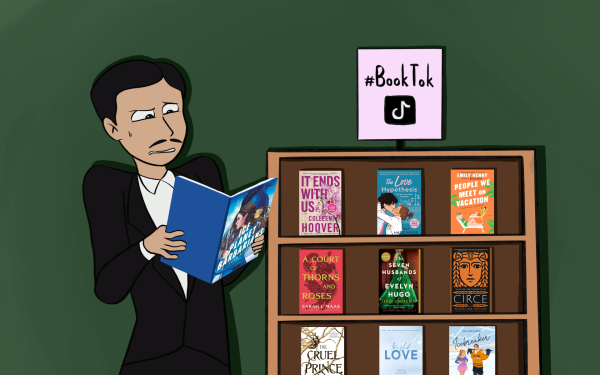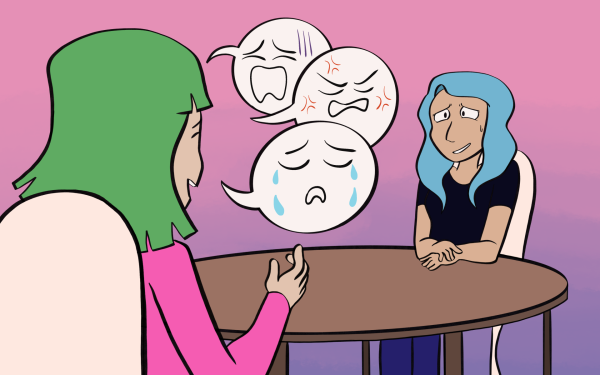OPINION: Anti-lockdown protesters are missing the point
By gathering in a public setting without masks, gloves or maintaining a safe distance, they are only prolonging the stay-at-home orders.
Reopen Illinois protesters rally outside Thompson Center in downtown Chicago, Saturday, May 16, 2020, during the coronavirus pandemic. (AP Photo/Nam Y. Huh)
“Reopen Ohio!” “Show us the data!”
These were among some of the several chants echoing outside Ohio’s Statehouse in Columbus, demanding facts and answers as citizens protested against the orders of social distancing.
As of May 17, there have been a total of 4,687,320 confirmed cases of COVID-19 globally, totaling 313,127 deaths and 1,720,446 recoveries. However, citizens across the country are demanding that restrictions designed to slow the spread of the virus be stopped.
As social distancing extends into the coming summer months, citizens nationwide are taking part in rallies, demanding for the orders to be ceased.
“My initial reaction was there’s a lot of misinformation out there,” said Michigan State Rep. Abdullah Hammoud. “And the importance of social distancing — [any] explanation of social distancing and what it means to social distance — to ‘flatten the curve, that was [just] a big information gap. Secondly, I think part of what was frustrating with the media, a lot of [the] media had made COVID-19 very partisan. Because the virus doesn’t care if you’re republican or democrat, but I feel like there’s an over-emphasis on that, unfortunately, in the news.”
There have been a total of 245 protests that have been carried out nationwide throughout April and early May, according to Vox. The protests have gathered up to a total of approximately 35,000 to 47,000 protestors.
Although citizens have their first amendment rights to protest, these actions go against the efforts the rest of the world is trying to implement to decrease the number of cases and create a safe and healthy environment.
These large gatherings of protestors are not wearing masks or gloves and are not using disinfectants, which disrespects crucial guidelines for preventing the spread of the virus in public.
They are demanding for the world to go back to normal when there are still thousands that are dying, recovering and looking out for the welfare of their families, friends and neighbors.
“Absolute individual freedom that leads to large loss of life and affects the weak and sick goes against any democratic norms in a free society,” said Dr. Faisal Jafri, a physician and founder of medical radio show, Code Blue Radio. “Protests also need to follow the guidelines of the state based on public health advice from evidence-based data from prior pandemics. Sadly the same group that prides itself of ‘[following] the law’ was breaking the law for its own political agenda.”
The protests that are being carried out are a complete paradox in terms of what they’re demanding and why it’s not being given to them. People want their lives to go back to normal. Students want to go back to school and see their friends. Workers want to go back to their offices and to help people around the world. The only way we will ever experience those opportunities, safely, is if we stay home, social distance ourselves, and implement healthy habits in our household.
Patients can be asymptomatic, meaning that by the time the virus has infected their body, numerous others could be infected and they won’t know. It’s complete disobedience against the urgent decisions that are being put into place for the welfare of all of mankind.
“None of these protests are anything close to peaceful, and it paints a picture as to the efficacy of such a flawed argument in the first place,” said DePaul junior Austin Daly. “Just as well, the misinformation of it [is] just as deadly, or will become just as deadly if we don’t [affect] massive [change] in the coming months. Because when the group that thinks they’re on top begins to realize they might not be on top, they press so much harder onto the weaknesses of others to keep that spot, no matter the cost.”
These rallies are not only impacting the welfare of communities nationwide, but they are also impacting the health of reporters.
In the Columbus protest, Adrienne Robbins, a reporter at the local NBC affiliate wearing a surgical mask to abide by the government issued guidelines, asked a protester to give her space. The woman refused as she continued to express in a raised voice her complaints about the media and NBC, accusing them of “lying to the American people.”
“In short, someone has to tell them they are being stupid and the only one who they will listen to is the one who resides on 1600 Pennsylvania Avenue,” said Ali Raza Moosvi, the New Jersy chief of cardiology and head of catheterization lab. “And unfortunately, he is a huge reason why they are on the streets to begin with.”
Robbins isn’t the only journalist that has experienced an altercation with protestors. Journalists, nationally and internationally, have become victims to assault during these protests.
We have no vaccine that can guarantee a cure for the virus. Hospitals are running out of equipment needed for the protection of doctors and nurses. Families, globally, are losing their loved ones. Social distancing is the only solution we have to bring lasting change for the welfare of global health.
The data, facts and answers are all open to the disposal of the public — it is up to the citizens of the nation to decide whether they will help us in this global battle, or will we be at risk for potentially deadlier waves to come.
Correction: A previous version of this story used an incorrect spelling of a source’s name. It has since been updated with the correct spelling.













Sheldon Finfrock • May 22, 2020 at 7:19 am
“None of these protests are anything close to peaceful, and it paints a picture as to the efficacy of such a flawed argument in the first place,” said DePaul junior Austin Daly. “Just as well, the misinformation of it [is] just as deadly, or will become just as deadly if we don’t [affect] massive [change] in the coming months. Because when the group that thinks they’re on top begins to realize they might not be on top, they press so much harder onto the weaknesses of others to keep that spot, no matter the cost.”
Ah, to have the luxury of being a metrosexual, far left leaning, Birkenstock wearing clueless DePaul University student. Mr Daly, from atop his Bughouse Square soapbox, pontificates for all the world to see. One wonders what, precisely, he suggests short of infinite quarantine and social distancing. Oh, I know, let’s isolate from all socail interaction entirely and continue to deny hard working and conscientious Americans the right to earn a living while the round mound of sound, JB Pritzker and his minion shovel horse manure as “essential” workers from one of several out of state horse farms.
I’m not sure to what “change” Mr. Daly is referring but these words emanate from somebody who clearly has no idea of how the real world works. Perhaps someday he will when and if he’s migrated from the overpriced ivory tower that is DePaul University and joins the ranks of the “9-5” crowd that needing to put bread on its table and, low and behold, send its own offspring to overpriced and marginal universites like DePaul.
It’s great to be able to